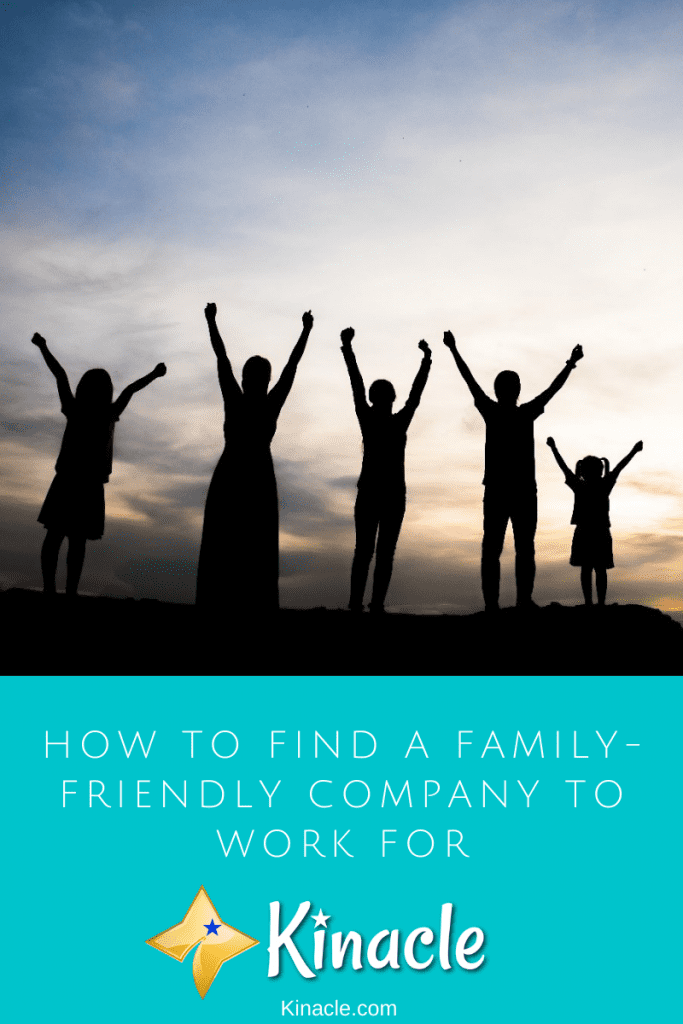
Work and family responsibilities can sometimes be a difficult balancing act but working in a family-friendly company can help even the scales. Get some practical tips on how to spot a family-centered company here.
This is Lucy*.

Lucy loves her job. She is a young, single mom who works at a placement firm for community nurses and caregivers. She finds deep satisfaction in being able to match licensed healthcare providers into families that need specific care. Every once in a while Lucy receives touching thank you notes usually from parents of children who have special needs. She neatly tacks them up her cubicle along with happy photos of her two children, ages 3 and 7 ½ months. It keeps her inspired.
Sometimes work can be difficult, what with the daily demands of child care or one her kids occasionally getting the flu or tummy ache, being a single working mother is never easy.
What eases Lucy’s everyday burdens is that she’s lucky to belong to a family-friendly workplace that supports her role as a single mother. This was primarily the reason why she stayed on in the company. They supported her through her divorce, were generous with parental leaves for little emergencies and events at school and, even if the company is small, they’ve given her annual performance raises during all of her work anniversaries for a job well done.
It wasn’t perfect, though. No place ever is.
But she managed to get through all her challenges with a smile on her face and after 7 years of hard work, Lucy was finally offered a big promotion in the HR department. She was excited at the prospect. But then came a surprising plot twist –a huge company was looking for an experienced recruiter and Lucy fit the bill. She was referred by one of her current clients, who also happened to work there. A much larger company with offices around the world, they offered a much higher pay, as well. Lucy was tempted and, feeling a bit guilty, she did a bit of research.
It didn’t take a lot of time to find out that even if the company was pretty impressive and the perks were excellent, they definitely weren’t family-friendly.
For Lucy, her family is a priority. Regardless of pay, a company that didn’t have a work culture that supported parents like her is something she would not consider. Maybe if her circumstances were different, she’d consider it. So, Lucy politely declined the offer and decided to stay where she was.
*Please note the photo above is a royalty-free stock photo and Lucy’s story is fictitious and used only as an example.
The challenge of many parents today, work-life balance seems like an elusive Holy Grail that Lucy, and very few others like her, have somehow managed to find. However, adopting family-friendly policies and culture in the workplace is very important for the American workforce. After all, majority of our employed citizens are parents.
According to the 2018 results from the Bureau of Labor Statistics of the U.S. Department of Labor:
- At least one parent was employed in 90.8 percent of families with children.
- Among married-couple families with children, 97.4 percent had at least one employed parent and 63.0 percent had both parents employed.
- Among families maintained by fathers, 84.2 percent of fathers were employed in 2018, a greater share than the 74.1 percent of employed mothers in families maintained by mothers.
Results from reputable researchers also show that more and more employers and businesses nowadays are aware that it isn’t always possible for family life and work life to become two, separate, compartmentalized entities.
Bottom line is – life happens and companies who understand that have better chances of hiring the best, most hardworking employees since they support not just their careers but also what happens in their personal lives and families, as well.
In fact, many multi-billion dollar companies and brands provide innovative family-friendly perks in order to hire top talent and keep them on.
Here’s a quick list of 5 giant companies that make the best efforts to create a family-centered workplace:
1. Google

Tech-giant and everyone’s favorite go-to search engine, email provider, and personal-use cloud storage, Google is especially famous for all the perks it provides to all its employees (free food and culinary lessons, among others).
For parents, though – they go all out. These are the amazing benefits they give to parents and their children:
- 18 weeks of paid leave for new dads
- 22 weeks of paid leave for new moms
- 4 fully-staffed childcare centers near their campus in Mountain View, California
- 12 weeks leave for parents who want to play a more involved role in their child’s first year
- $500 “baby bonding” cash incentive to new parents
If you’re looking for more reasons to envy Google’s company benefits – you can learn more here.
2. Patagonia

A household name among outdoor enthusiasts, Patagonia designs and sells one of the world’s best outdoor apparel and gear. Not only are they nature-friendly, they’re extremely family-friendly, as well.
Take a peek at some of the benefits their employees can look forward to if they plan to have children:
- Help with adoption fees – for parents planning to adopt, Patagonia helps ease the burden of this oftentimes complicated and expensive process by chipping in with adoption expenses.
- After-school care – company buses pick up kids from local schools and take them back to their headquarters so parents need not worry about rushing out of the office to pick up kids.
- On-site childcare center – this really helps moms and dads in their transition to coming back to work after their parental leaves.
- Company-paid childcare – breastfeeding moms can enjoy peace of mind when travelling for work as the company pays for a family member or one of their caregivers from their on-site childcare center to accompany them.
3. American Express

More than just a credit card, American Express describes itself as “a globally integrated payments company, providing customers with access to products, insights and experiences that enrich lives and build business success.” In January 2017, AmEx also rolled out game-changing parental leave for both moms and dads offering birth moms, adoptive, foster, surrogate and LGBTQ parents a full 20 weeks (4 months) of paid parental leave.
Apart from increased parental leave, employees are also eligible for:
- Reimbursement of expenses up to $35,000 to help with the cost of an adoption or surrogacy event (up to a maximum of two events per employee);
- A lifetime maximum benefit of $35,000 for reproductive and fertility treatments, available under the company’s health plans;
- Free 24-hour access to board-certified lactation consultants; and
- Free breast-milk shipping while traveling on company business.
4. Facebook

Offering the one of the best family benefits, parents working for Facebook are definitely enjoying some enviable perks:
- $4000 in cash for new parents to spend however they wish for their newborns.
- Subsidized payments for childcare and adoption fees.
- 16 weeks of paid maternity and paternity leave plus 5 weeks of maternity leave (based on community contributions from career-review website Fairygodboss).
In addition, Facebook perks boast of:
- Support for family planning, including adoption and surrogacy assistance
- Flexible spending account for dependent care so you can pay care expenses for a child or parent with pre-tax money
- Access to information, resources and programs to support your family care needs.
5. Johnson & Johnson

Definitely a brand name that every parent recognizes, Johnson & Johnson’s iconic yellow baby shampoo and blue-and-white baby powder are baby bath essentials that are stocked in grocery stores not just in the U.S., but in almost all other countries around the world, as well.
Apart from their family-friendly products, J & J also has some of the best parent perks:
- J & J pioneered on-site day care center in the 90’s. Today, they have 7 on-site childcare centers to cater to parents and their children.
- New moms are provided with 17 weeks of paid leave and 9 weeks for dad. Maternity/paternity leaves also do not need to be taken consecutively, as well.
- The company assigns nurses to pregnant women to ensure the safest pregnancy as possible.
This article perfectly encapsulates Johnson and Johnson’s efforts to make their company amazing for working parents.
Needless to say, the above companies certainly put their best foot forward when it comes to ensuring that parents working for them are supported well so that work becomes easier. New parents will also find it smoother to transition from having a baby to going back to work if they know for sure that they have the best childcare benefits.
As great as thee above companies are though, the reality is that not all of us can jump into a flourishing career in Google or Facebook; especially if we’ve just had kids or have spent several years raising children and thinking about going back into the workforce.
More importantly, it’s good to remember that not just giant companies can offer family-friendly benefits. Many other companies and businesses, even the small or medium-sized ones, make great efforts to ensure that parents in their workforce are supported in the best way possible.
The trick is to know how to spot family-friendly companies even before you start working for them. And, as a family-friendly company ourselves, we offer little tidbits of wisdom for you:

These tips are especially helpful if you are:
- Looking to transition back from being a stay-at-home-parent to office-based work.
- Preparing to interview for a new job and you’re researching to see if they are family-friendly.
- Checking to see if the company you are currently employed in is going into a family-friendly direction.
First things, first:
Review the job post and read between the lines.
Business owners and their HR staff know that to attract top talent, they must also offer family-friendly perks – and this can all be initially communicated via the job ad.
If it’s not mentioned outright e.g. “We’re a family-centered company and many parents love working for us!”, you can usually find it in the wording of the job ad. You can look for signs like “flexible schedule” or “we advocate work-life balance”. Most job posts will also mention a quick rundown of benefits. Look for family-friendly benefits like “parental leave”, “ability to choose a shift that works for you” or “work-from-home options”.
While reviewing family-friendly code words/phrases, read between the lines for any benefits they offer, as well. Some businesses offer incentives like “company paid phone plan”, “24-hour gym access” or “great travel perks” and while these are all great – they may not be so good for parents.
Why?
If they provide you with a phone – this might mean that they can call you any time of the day. If they give you unlimited gym access, this may mean their employees are expected to work late and, therefore, make gym access available for those who want to work out after hours. For travel perks, that needs to be clarified because that may mean the company will need you to travel often, making it difficult for you to arrange childcare, etc.
Take your time and research, research, research.
Being burnt out from caring for children or being stressed out from being a stay-at-home parent should not be a reason to rushing into jumping back to the workforce. Some parents feel like work can sometimes be like a “vacation” away from home – no children, no chores – but it isn’t. As we all know, it brings about different kinds of stress and will only add to your burdens at home.
If you are currently employed in a company that doesn’t quite support the needs of parents, jumping into another job right away isn’t the answer, as well. You can always reach out to your HR department, your boss or simply talk things over with workmates. They may also share the same burdens and might have suggestions for you.
The bottom line is that searching for other jobs requires for you to take your time. Especially for parents where every decision that is made affects the family.
Apart from deciding carefully and taking time, research is important.
Whether it’s looking at the company’s reviews online, reaching out to friends who have worked in the same place or friends who work currently work there or checking out the company’s website – doing careful research to find out a company’s family-friendly policies and work culture is definitely worth your time.
Should you be called in for an interview at the office, quietly and discreetly observing these simple things can give you an indication of exactly how family-friendly they are:
- Family photos and mementos like kids’ drawings and notes on the employees’ desks.
- Recent posts on their company bulletin boards about family outings and events.
- On-site daycare or childcare services are available.
- On-site breastfeeding/lactation rooms.
Ask the right questions during the interview or job offer.
During opportune times, ask the interviewer discreet questions that will help give you an idea of what it’s like to work for them.
Some ideas for questions are:
- What’s a typical work day like?
- I’d love to meet other parents, too. Are there lots of parents here?
- Speaking of schedule, do you offer flexible shifts for parents like me?
- Is it possible to work remotely if needed?
Also, it’s not a good idea to ask outright about company policies and family-friendly workplace policies immediately during the interview. Once they express interest in having you onboard – that’s the perfect time to ask additional questions. If you have the opportunity during the job offer, going over the company handbook is also a great way to see what their policies are before asking about it.
Review company values, mission/vision and scan through awards received.
When checking the company’s website, other than scanning through the usual About pages, Products/Services and Reviews, it’s also a good idea to find out what their values are and their mission/vision for the company, as well. This is usually where you can determine if they are people-centric rather than work or output-centric. The company’s vision and mission will also tell you, in a nutshell, the general direction the company is headed towards.
Checking through any awards received by the company will also give you a hint about their achievements. Companies and brands that create innovative policies and efforts that help their employees will most likely be recognized by their industry and business leaders.
An open-minded work culture that allows expansion of current benefits to different stages of life – not just parenthood.
Sometimes, emerging and newer companies or businesses may not have family-friendly benefits in place as of yet as they may still be formulating their own identity.
However, the direction of the company may also be dependent on its open-mindedness. If generally, the company has policies in place that support single mothers, single fathers, the LGBTQ, women’s rights and are open to flexible work schedules and output-driven work vs. time-driven work, then it may be an ideal workplace for parents, as well.
For example, if the office doesn’t have a lactating room yet and they see, that over the course of a few years, they hire quite a few new moms who are doing exceptionally well at work, then they are open to creating a breastfeeding room to help their breastfeeding moms.
Companies and businesses who have a broad-minded approach on things usually are able to support employees with children and will do their best to meet their needs – not just in the new stages of parenthood but throughout every milestone and life phases, as well.
If you feel that your current company needs to head in a more parent-friendly direction, we reiterate that it’s best to open up to HR or your manager first before making any rash decisions.
Conclusion
In these uncertain times of a global pandemic, more and more people are appreciating companies that are doing their best to support their employees and their families. Searching for a family-friendly workplace isn’t impossible – it just takes time and a bit more research.
Do you have any more tips for us? Or do you have your own story to share? Let us know! We’d love to hear from you.
Leave a Reply